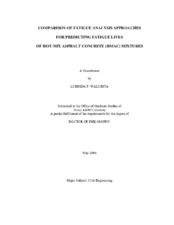Comparison of fatigue analysis approaches for predicting fatigue lives of hot-mix asphalt concrete (HMAC) mixtures
| dc.contributor.advisor | Matin, Epps, Amy | |
| dc.creator | Walubita, Lubinda F. | |
| dc.date.accessioned | 2006-08-16T19:08:19Z | |
| dc.date.available | 2006-08-16T19:08:19Z | |
| dc.date.created | 2003-05 | |
| dc.date.issued | 2006-08-16 | |
| dc.identifier.uri | https://hdl.handle.net/1969.1/3898 | |
| dc.description.abstract | Hot-mix asphalt concrete (HMAC) mixture fatigue characterization constitutes a fundamental component of HMAC pavement structural design and analysis to ensure adequate field fatigue performance. HMAC is a heterogeneous complex composite material of air, binder, and aggregate that behaves in a non-linear elasto-viscoplastic manner, exhibits anisotropic behavior, ages with time, and heals during traffic loading rest periods and changing environmental conditions. Comprehensive HMAC mixture fatigue analysis approaches that take into account this complex nature of HMAC are thus needed to ensure adequate field fatigue performance. In this study, four fatigue analysis approaches; the mechanistic empirical (ME), the calibrated mechanistic with (CMSE) and without (CM) surface energy measurements, and the proposed NCHRP 1-37A 2002 Pavement Design Guide (MEPDG) were comparatively evaluated and utilized to characterize the fatigue resistance of two Texas HMAC mixtures in the laboratory, including investigating the effects of binder oxidative aging. Although the results were comparable, the CMSE/CM approaches exhibited greater flexibility and potential to discretely account for most of the fundamental material properties (including fracture, aging, healing, visco-elasticity, and anisotropy) that affect HMAC pavement fatigue performance. Compared to the other approaches, which are mechanistic-empirically based, the CMSE/CM approaches are based on the fundamental concepts of continuum micromechanics and energy theory. | en |
| dc.format.extent | 1842533 bytes | en |
| dc.format.medium | electronic | en |
| dc.format.mimetype | application/pdf | |
| dc.language.iso | en_US | |
| dc.publisher | Texas A&M University | |
| dc.subject | CMSE | en |
| dc.subject | CM | en |
| dc.subject | ME | en |
| dc.subject | MEPDG | en |
| dc.subject | Fatigue | en |
| dc.subject | Cracking | en |
| dc.subject | Asphalt mixtures | en |
| dc.subject | Fracture | en |
| dc.subject | Aging | en |
| dc.subject | Anisotropy | en |
| dc.subject | Visco-elastic | en |
| dc.subject | Pseudo strain energy | en |
| dc.subject | Surface energy | en |
| dc.subject | Continum | en |
| dc.subject | Micro-mechanics | en |
| dc.subject | Healing | en |
| dc.subject | Non-linear | en |
| dc.subject | Work potential theory | en |
| dc.subject | Fracture mechanics | en |
| dc.subject | Calibrated mechanistic | en |
| dc.title | Comparison of fatigue analysis approaches for predicting fatigue lives of hot-mix asphalt concrete (HMAC) mixtures | en |
| dc.type | Book | en |
| dc.type | Thesis | en |
| thesis.degree.department | Civil Engineering | en |
| thesis.degree.discipline | Civil Engineering | en |
| thesis.degree.grantor | Texas A&M University | en |
| thesis.degree.name | Doctor of Philosophy | en |
| thesis.degree.level | Doctoral | en |
| dc.contributor.committeeMember | Little, D. | |
| dc.contributor.committeeMember | Lytton, R. L. | |
| dc.contributor.committeeMember | Speed, M. | |
| dc.type.genre | Electronic Dissertation | en |
| dc.type.material | text | en |
| dc.format.digitalOrigin | born digital | en |
Files in this item
This item appears in the following Collection(s)
-
Electronic Theses, Dissertations, and Records of Study (2002– )
Texas A&M University Theses, Dissertations, and Records of Study (2002– )


